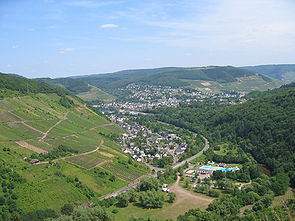|
Alf, Rhineland-Palatinate
 Alf is an Ortsgemeinde – a municipality belonging to a Verbandsgemeinde, a kind of collective municipality – in the Cochem-Zell district in Rhineland-Palatinate, Germany. It belongs to the Verbandsgemeinde of Zell, whose seat is in the municipality of Zell an der Mosel. GeographyLocationAt Alf, the Alf, or Alfbach, empties into the Moselle. The municipality lies on the Moselle's left bank. The municipal area measures 6.33 km2, of which 0.67 km2 is vineyards and 3.79 km2 is wooded. Neighbouring municipalitiesTwo neighbours are Bullay and Pünderich, both on the right bank. Constituent communitiesAlf's Ortsteile are the main centre, also called Alf, and the outlying centres of Höllenthal and Alf-Fabrik. The latter is historically an industrial centre, as its name suggests (Fabrik means “factory” in German). Both these centres lie on the river Alf, inland from the Moselle. HistoryIn pre-Roman times, the place was inhabited by Celts. In 50 BC, Alf had its first documentary mention under the Latin name Albis. The modern name is derived from this. At this time, it was a Roman settlement. In the Middle Ages, Alf belonged to the lordship whose seat was at the nearby Castle Arras, and which was in turn an Electoral-Trier fief. According to legend, a charcoal maker named Arras was enfeoffed with the holding by the Archbishop of Trier as thanks for his, and his twelve brave sons’, deed of having beaten back a great horde of Hungarians in the Alfbach valley. What is known to history, though, is that Count Palatine Herrmann, on the spot that had quite possibly been fortified as far back as Celtic times, had the castle built in 938 as a defensive facility against Hungarian incursions. In the many centuries that followed, the castle fell into disrepair, but it was rebuilt between 1907 and 1910. Since then, the castle has been inhabited, but is nonetheless open to visitors, affording them views of the Alfbach valley, the Moselle, the Kondelwald and the Hunsrück.[3] Beginning in 1794, Alf lay under French rule. In 1815 it was assigned to the Kingdom of Prussia at the Congress of Vienna. Since 1946, it has been part of the then newly founded state of Rhineland-Palatinate. Under the Verwaltungsvereinfachungsgesetz (“Administration Simplification Law”) of 18 July 1970, with effect from 7 November 1970, the municipality was grouped into the Verbandsgemeinde of Zell. PoliticsMunicipal councilThe council is made up of 12 council members, who were elected by proportional representation at the municipal election held on 7 June 2009, and the honorary mayor as chairman. The municipal election held on 7 June 2009 yielded the following results:[4]
MayorAlf's mayor is Miriam Giardini-Molzahn, successor of Peter Mittler (SPD), who held office from 2009 to 2019. Coat of armsThe municipality's arms might be described thus: Gules in base an inescutcheon couped bendwise sinister in dexter chief argent charged with a cross enhanced of the field, standing thereupon a bishop, in his dexter hand a bunch of grapes and in his sinister a bishop's staff, all Or. Culture and sightseeingMuseumsAlf's small local history museum has displays about the village's industrial history. BuildingsWorth seeing is Castle Arras looming above the village, built in the early 12th century. Also nearby stands another castle, the Marienburg in the neighbouring municipality of Zell. The village's landmark is the belltower at the parish church built in 1734 and later remodelled in Gothic Revival style. There is also a well known statue, Christus in der Rast, from the 15th century. A few hundred metres from the village centre stands the Electoral-Trier Amtshaus built in the 16th century, a three-floor stone building. The roof was refurbished about 1620[5] The following are listed buildings or sites in Rhineland-Palatinate’s Directory of Cultural Monuments:
Economy and infrastructureEstablished businessesThe biggest employer in Alf and the surrounding region is the Finnish packaging company Huhtamäki, which maintains one of its 70 or so plants worldwide in the outlying centre of Alf-Fabrik. It makes stiff plastics and hard paper for packaging purposes. TransportAcross the river from Alf lies the bigger centre of Bullay with a railway station on the Koblenz-Trier railway, easily reached over the Alf-Bullay double-deck bridge. Alf is the location of the junction of Bundesstraßen 49 and 53. Famous peopleSons and daughters of the town
SundryAfter the great success of the US television programme ALF, the roadsign bearing the municipality's name was stolen many times in the late 1980s in a situation similar to what had been happening to Fucking in Austria. To stem the rash of thefts, the municipality finally offered copies of the roadsign for sale, printed on one side only. To make these signs distinguishable from the ones that were actually posted at the roadside, they had the municipal stamp and the mayor's signature on the back. References
External linksWikimedia Commons has media related to Alf (Mosel). |
|||||||||||||||||||||||||||||||||||||||||||||||||||||||||||||




